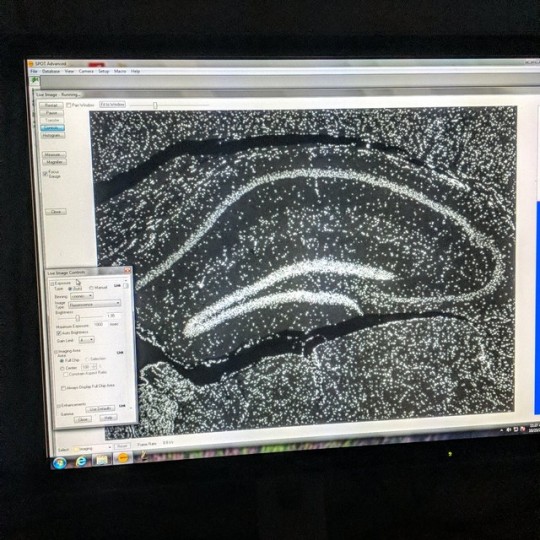Photo




Dissolution of a Grubbs type olefin metathesis catalyst in dichloromethane.
Olefin metathesis reaction is a “modern” transformation used in organic chemistry. This reaction allows the exchange of substituents between different olefins. As a simplified scheme this happens:

This reaction was first used in petroleum reformation for the synthesis of higher olefins (Shell higher olefin process - SHOP), with nickel catalysts under high pressure and high temperatures. Nowadays, even polyenes with MW > 250,000 are produced industrially in this way.
Grubbs’ catalysts are a series of transition metal carbene complexes used as catalysts for olefin metathesis. They are named after Robert H. Grubbs, the chemist who supervised their synthesis. Several generations of the catalyst have been developed. Grubbs’ catalysts tolerate many functional groups in the alkene substrates, are air-tolerant, and are compatible with a wide range of solvents. For these reasons, Grubbs’ catalysts have become popular in synthetic organic chemistry. Some of the most popular Grubbs catalysts:

For their elucidation of the reaction mechanism and their discovery of a variety of highly active catalysts, Yves Chauvin, Robert H. Grubbs, and Richard R. Schrock were collectively awarded the 2005 Nobel Prize in Chemistry.
499 notes
·
View notes
Photo



06/12/2018
The synthesis of tioxolone.
265 notes
·
View notes
Photo



30/11/2018
The synthesis of methenamine (urotropin).
125 notes
·
View notes
Photo

27/11/2018
Toxicology
We’re working with blood today and we made blood ethanol test.
28 notes
·
View notes
Photo


05/03/2018
Drug Chemistry - conductometric titration of tetracainium chydrochloridum
187 notes
·
View notes
Photo

funnel
4K notes
·
View notes
Text

The chem memes get me.
309 notes
·
View notes
Text
Molecule of the Day: Ammonia


Ammonia (NH3) is a binary compound of nitrogen and hydrogen. Commonly found in nature, it exists as a pungent, colourless gas under standard conditions, but is often sold as a solution in water. It is one of the most widely produced chemicals in the world, with 146 million tonnes being produced in 2016 alone.
Ammonia is a weak base, with a pKb of 4.75; it can reversibly react with water to produce ammonium and hydroxide ions.
NH3 + H2O ⇌ NH4+ + OH-
Due to the equilibrium shown above, solutions containing ammonia and ammonium ions are commonly used as buffer solutions, which resist pH changes upon addition of small amounts of acids or bases.
At the same time, ammonia can also act as an acid with very strong bases and reactive metals. For example, sodium metal reacts with ammonia to produce sodium amide, a strong base:
2 Na + 2 NH3 → 2 NaNH2 + H2
With its lone pair, ammonia can also coordinate to metal ions, resulting in colourful metal ion complexes, such as the deep blue tetraamminecopper(II) ion:

Ammonia is a versatile starting block for many chemical and fertiliser industries, as it offers a convenient way to introduce a nitrogen atom into a molecule. Being a nucleophile, it can participate in nucleophilic substitution and addition-elimination reactions, a useful trait that is exploited in many chemical syntheses. For example, the first step in the Strecker amino acid synthesis, which allowed chemists to synthesise amino acids for the first time instead of extracting it from organic material, involves the usage of ammonia to convert an aldehyde into an imine.

Ammonia is industrially produced by the Haber process, in which nitrogen is reacted with hydrogen under moderate temperature and high pressure in the presence of a catalyst to produce ammonia according to the following equation:
N2 + 3 H2 ⇌ 2 NH3

As the reaction is reversible, the reaction mixture is then cooled to condense the ammonia, and the leftover hydrogen and nitrogen is pumped back into the reactor to participate in the reaction again, thus maximising yield.
Ammonia is a metabolic waste from the digestion of proteins and other nitrogen-containing products, and is excreted through the urine. It is also produced from the decomposition of tissues.
While ammonia is present in many tissues, it is metabolised into urea rapidly in the liver via the urea cycle, as urea is much less toxic and basic, and the buildup of ammonia can result in liver cirrhosis.

478 notes
·
View notes
Photo




A Kinetic Sculpture Built from over 600 Parts Gracefully Imitates a Swimming Sea Turtle
1K notes
·
View notes
Text

Look at this neat brain everybody
107 notes
·
View notes
Photo




16/11/2018
The synthesis of salicylamide.
949 notes
·
View notes
Photo



19/10/2018
The synthesis of magnesium aspartate.
513 notes
·
View notes
Photo

This is a false coloured image of pollen from different plant species taken with a Scanning Electron Microscope (SEM).
Pollen is a minute mass of microspores that are produced in seed plants. These tiny grains are formed in the anther of a male plant and are subsequently transported via wind, water or insects etc to the pistil of a female plant, where fertilisation occurs.
Pollen grains may be small, but they are mighty.
Keep reading
202 notes
·
View notes
Text

This shows that the probability of a random variable is maximum at the average and diminishes as one goes away from it, eventually leading to a bell-curve.
4K notes
·
View notes
Photo




07/05/2018
Drug Chemistry
Iodometric titration of acidum ascorbicum (Ascorbic acid/Vitamin C) from tablet with starch indicator.
100 notes
·
View notes

